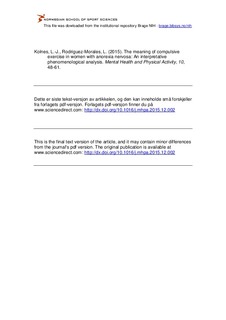| dc.contributor.author | Kolnes, Liv-Jorunn | |
| dc.contributor.author | Rodriguez-Morales, Lymarie | |
| dc.date.accessioned | 2017-12-11T13:50:03Z | |
| dc.date.available | 2017-12-11T13:50:03Z | |
| dc.date.issued | 2015-12-29 | |
| dc.identifier.citation | Mental Health and Physical Activity. 2016, 10(Mars 2016), 48-61. | nb_NO |
| dc.identifier.uri | http://hdl.handle.net/11250/2470412 | |
| dc.description | I Brage finner du siste tekst-versjon av artikkelen, og den kan inneholde ubetydelige forskjeller fra forlagets pdf-versjon. Forlagets pdf-versjon finner du på sciencedirect.com / In Brage you'll find the final text version of the article, and it may contain insignificant differences from the journal's pdf version. The definitive version is available at sciencedirect.com | nb_NO |
| dc.description.abstract | Background: Despite the substantial role of compulsive exercise in the development and maintenance of anorexia nervosa, and despite associated risks of medical complications, longer length of hospitalization and higher relapse rates, little is understood about the personal experience and meaning of compulsive exercise in this context. This study explored the experiences of compulsive exercise in women with anorexia nervosa, restrictive type, and the sense they make of these experiences in the context of their daily lives and treatment programme. Methodology: Semi-structured interviews were conducted with six females, four of whom were former athletes. Transcripts were subjected to interpretative phenomenological analysis (IPA). Findings: This paper reports on the first superordinate theme, paradoxical functions of exercise. An account of the participants' perspectives regarding their engagement with compulsive exercise as a means of emotion regulation is presented first. Secondly, the manner in which participants experience the embodiment of emotional states is explored. Thirdly, the ability of exercise to offer participants a sense of time-out is presented. Finally, the meaning of exercise in relation to the participants' sense of self and identity are analysed. Conclusions: The study demonstrates how compulsive exercise represents an essential means of emotion distraction and management for individuals with anorexia nervosa. The finding that feelings are echoed in the participants' bodies is significant, as this gives participants a sense of connecting with their emotions. The time outs offered by exercise provide a degree of structure, control and stability for the participants' sense of self, helping them commit to the demands of treatment. However, this control and stability is short lived, as it may lead to a subsequent loss of control if underlying concerns and emotions are not addressed. It is suggested that interventions should aim to increase recognition and tolerance of negative feelings. Body-oriented and physical therapy interventions tailored specifically to individuals with anorexia nervosa may provide a fresh way of addressing emotions that is complementary to other therapies. | nb_NO |
| dc.language.iso | eng | nb_NO |
| dc.publisher | Elsevier | nb_NO |
| dc.subject | anorexia nervosa | nb_NO |
| dc.subject | compulsive exercise | nb_NO |
| dc.subject | emotion regulation | nb_NO |
| dc.subject | embodied feelings | nb_NO |
| dc.subject | self and identity | nb_NO |
| dc.subject | IPA | nb_NO |
| dc.title | The meaning of compulsive exercise in women with anorexia nervosa: An interpretative phenomenological analysis | nb_NO |
| dc.type | Journal article | nb_NO |
| dc.type | Peer reviewed | nb_NO |
| dc.description.version | acceptedVersion | nb_NO |
| dc.rights.holder | © 2015 Elsevier Ltd. All rights reserved. | nb_NO |
| dc.source.journal | Mental Health and Physical Activity | nb_NO |
| dc.identifier.doi | 10.1016/j.mhpa.2015.12.002 | |
| dc.description.localcode | Seksjon for idrettsmedisinske fag / Department of Sport Medicine | nb_NO |
